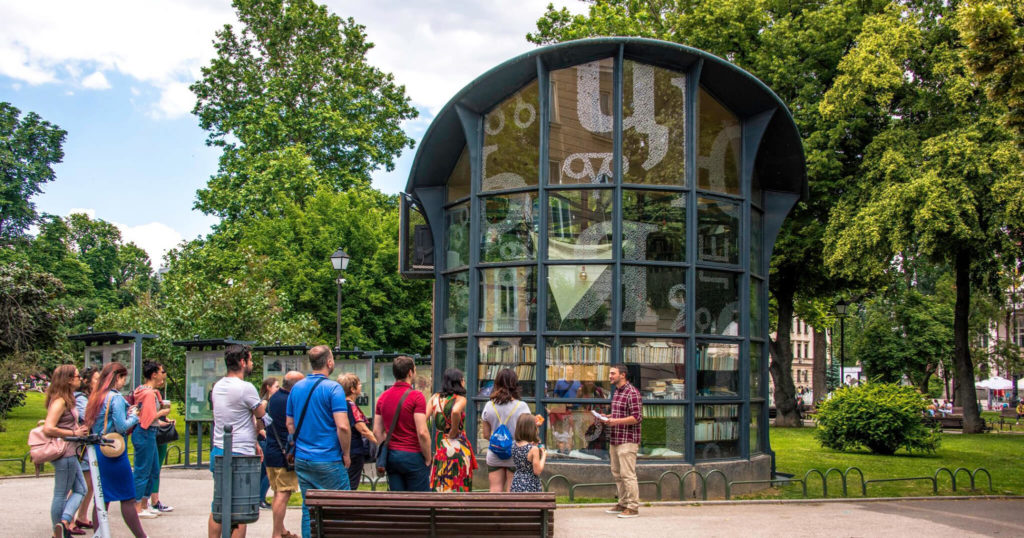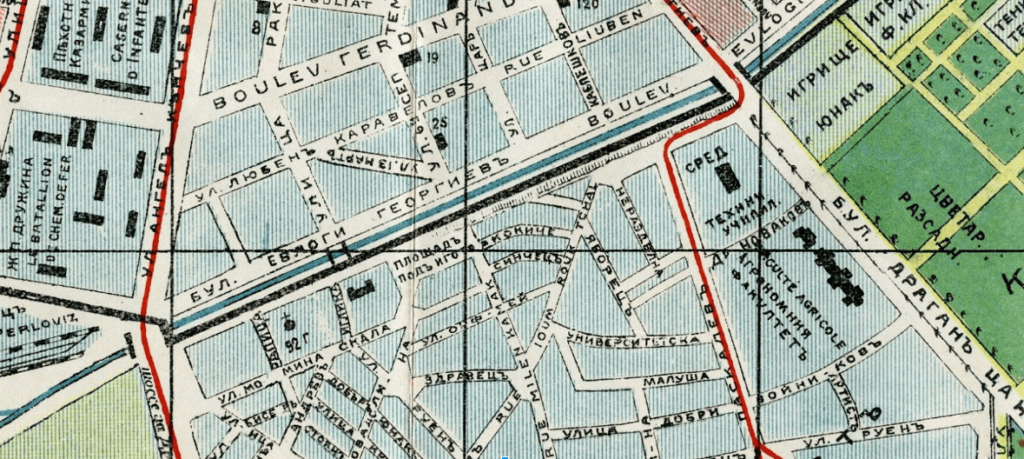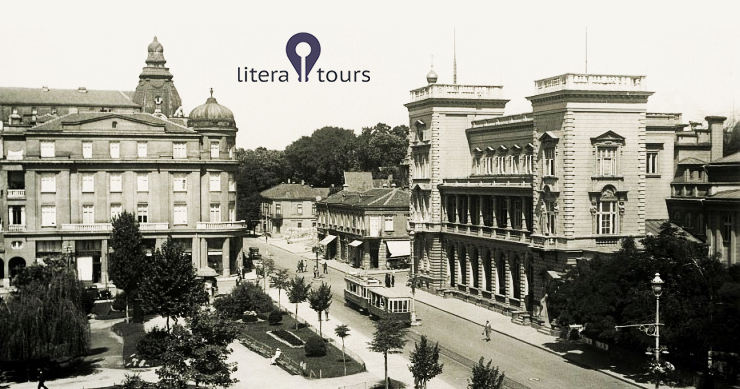Saturday, 1 PM, a crowd gathers at a small pavilion in the National Theatre Garden in Sofia. The writer Alexander Shpatov, with the excitement of a young teacher on schoolyear’s opening day, welcomes them to yet another literature tour.
What is a literature tour
Literature tours are a popular type of city walking tours. They cover the theme of lives and works of famous writers. Common stops are literary museums, theatres, libraries, bookstores, sometimes coffeehouses and inns, statues in parks, and even cemeteries, for reading epitaphs. There are many such tours in Europe. For example: a casual stroll from the house of Schiller to the house of Goethe in Weimar; warm bear drinking on the favorite table of Tolkien and Lewis in Oxford; climbing the tower in the center of the small Spanish town of Alcala de Henares, which commands a perfect view over the house of Miguel de Cervantes.
There is a similar literature tour held in Sofia, too. (Thumbs up!) It is organised by the “Union of City Reading Rooms” and it is guided by the famous young writer Alexander Shpatov. The litera tour in Sofia combines the stories of many national authors who lived in the end of 19th century and the beginning of 20th century, and form the canon of Bulgarian literature. Every student studies them at school: Ivan Vazov, Aleko Constantinov, Dimitar Dimov to name a few. The stories in the tour also include curious side characters such as legendary bookstore owners, publishers, compositors*, foreign ambassadors, and even His Majesty Tsar Ferdinand I of Bulgaria.
*Compositors are people who arrange type for printing into a composing machine; not to be mistaken with composers, people who write music.

Unexpected Success
The “Union of City Reading Rooms” stands behind the so-called “Literature map of Sofia”. It is an inventory of every street, square, building or monument connected to a famous writer. And while working on this map, the idea to promote it with thematic guided tours gradually formed. Without much expectations the first tours were held and lots of people turned out, intrigued about the format, myself included. The tours proved to be successful events and continue to happen for a third year. I dare say they became more popular than the literature map, which they were supposed to promote.
There is a secret behind this success, other than perseverance and the apparent charisma of the organisers. It is the sheer history combined with the unique layout of the Bulgaian capital city Sofia. The city itself is a kind of a storyteller, a meta-author of its own literature account. What does this mean?
Sofia, the crone storyteller
The city of Sofia presents countless topics for a literature tour itinerary. The reasons are two: (1) all Bulgarian classical authors, with almost no exceptions, had lived in the capital city around the same time, when (2) the city was still fairly small, compact.
Even though many authors hadn’t written a single line about Sofia, they most certainly had lived there. The best example is the author Yordan Yovkov. Although he lived for many years in Sofia, he is famous with short stories about the simple life in the Bulgarian village, describing the day-to-day hardship of the common countryman. There is a good reason for this. Sofia was the center of public life in the country. It was simply the place where things happen. The biggest publishers, booksellers, librarians were concentrated here, too. For every ambitious author it was a necessity to hang around and establish connections. That is very convenient for us because now there are references to all the important authors in one city.
And this city was very compact. The public life in Old Sofia (sometimes referred as Bohemian Sofia) was enclosed in a small perimeter that can be crossed side-to-side with a half-hour brisk walk. One end was marked with the Lion’s bridge, the other was marked with the Eagle’s bridge. Thus many literature-related places are located at a comfortable walking distance. This makes it possible to include more stories in the tour and to cover them in two hours. No rush.

Perhaps there is a third characteristic that makes Sofia a gold mine for literature walks: (3) there are references to writers at every turn, wherever you go. That is why I call Sofia a crone storyteller. For example, no less than 300 streets are named after writers, philologists, and literature characters. And only in Sofia, one can find entire neighborhoods dedicated to Bulgarian writers: Yavorov, Smirmensi, Hristo Botev, and some others.
The Coffeehouses
If anyone analysed the talk of Alexander Shpatov during the literature tours, I bet the most repeated noun will be “a coffeehouse**”
**Coffeehouse is an establishment where you drink your coffee while socializing; not to be mistaken with a coffee shop, a coffee bar, nor a café.
Very often, while talking about author’s biographies we tend to emphasise too much on the places where they lived such as family houses, rented apartments etc. Even though it may be interesting to see the chair, in which the author used to nap, or the drawer, where they kept their journal, these details speak little about the author’s character. If one wants to understand their temperament and inner world, one should seek to find out what had happened in the coffeehouses.
The coffeehouse is best described as the facebook of the time. It was the place for heated disputes over a casual game of backgammon. Here the news arrived first and the press (domestic and foreign alike) was read out loud. Public praises and public insults were also part of the atmosphere. Not a few iconic novels and the characters in them were invented on the tables of the most famous Sofian coffeehouses.
Many of these iconic places do not exist today. They are only preserved in archive pictures. But the literature tour is a time to revive their memory and revisit the locations where they once stood.
The tour provides an escape to the upbeat mood in the Armenian coffeehouse, visited only by the poorest writers; the gossips in the Bohemian bar “Bambuk”, the members-only Union Club; the Vienna restaurant “Pod Lipite”; and the legendary pastry shop “Tsar the Liberator”, named after the Russian Emperor Alexander II.
Union of City Reading Rooms: chitalnyata.bg
Photo in the beginning: stara-sofia.com
